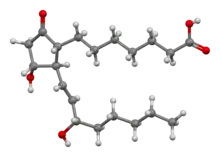Prostaglandin E1
Prostaglandin E1 (PGE1), also known as alprostadil, is a naturally occurring prostaglandin which is used as a medication.[1] In infants with congenital heart defects, it is delivered by slow injection into a vein to open the ductus arteriosus until surgery can be carried out.[2] By injection into the penis or placement in the urethra, it is used to treat erectile dysfunction.[3]
 | |
 | |
| Clinical data | |
|---|---|
| Trade names | Caverject, Muse, others |
| AHFS/Drugs.com | Monograph |
| MedlinePlus | a695022 |
| License data |
|
| Routes of administration | IV |
| ATC code | |
| Legal status | |
| Legal status | |
| Identifiers | |
IUPAC name
| |
| CAS Number | |
| PubChem CID | |
| IUPHAR/BPS | |
| DrugBank | |
| ChemSpider | |
| UNII | |
| KEGG | |
| ChEBI | |
| ChEMBL | |
| CompTox Dashboard (EPA) | |
| ECHA InfoCard | 100.010.925 |
| Chemical and physical data | |
| Formula | C20H34O5 |
| Molar mass | 354.487 g·mol−1 |
| 3D model (JSmol) | |
SMILES
| |
InChI
| |
| | |
Common side effects when given to babies include decreased breathing, fever, and low blood pressure.[1] When used for erectile dysfunction side effects may include penile pain, bleeding at the site of injection, and prolonged erection (priapism).[1] Prostaglandin E1 is in the vasodilator family of medications.[1] It works by opening blood vessels and relaxing smooth muscle.[1]
Prostaglandin E1 was isolated in 1957 and approved for medical use in the United States in 1981.[1][4] It is on the World Health Organization's List of Essential Medicines.[5]
Medical uses
Patent ductus arteriosus
Alprostadil is also used in maintaining a patent ductus arteriosus in newborns. This is primarily useful when the threat of premature closure of the ductus arteriosus exists in an infant with ductal-dependent congenital heart disease, including cyanotic lesions (e.g., hypoplastic left heart syndrome, pulmonary atresia/stenosis, tricuspid atresia/stenosis, transposition of the great arteries) and acyanotic lesions (e.g., coarctation of the aorta, critical aortic stenosis, and interrupted aortic arch).
Sexual dysfunction
Alprostadil is sold in the United States as urethral suppositories and in injectable form. The suppositories are sold under the brand name Muse.[6] The injectable forms are Edex[7] and Caverject.[8] Muse delivers alprostadil as a penile suppository, inserted into the urethra, at least ten minutes before the erection is needed. Caverject and Edex are similarly fast-acting, but instead are injected by syringe directly into the corpus cavernosum of the penis.
Alprostadil is also available as a generic. The major cost is that it must be mixed by a compounding pharmacy and supplies may be difficult to obtain. The different formulations, including Bimix and Trimix, may include papaverine and/or phentolamine. A typical mix might be 30 mg of papaverine, 2 mg of phentolamine, and 20 μg alprostadil. As a generic, it is much less expensive than the packaged injectables. It is premixed and must be kept refrigerated and the user must load a syringe with the quantity needed.
Most recently, the compound has been made easily accessible in an applicable topical cream form known as Vitaros.[9] Made by Takeda UK Ltd, it is now available in Europe and contains either 200 or 300 micrograms of alprostadil in 100 mg of cream which is directly administered as a topical cream applied to the urethra in a preloaded delivery device. The tip of the device is placed in the urethral meatus and the cream delivered into the urethra. Clinical trials for the treatment showed positive results in over 3000 men that it was tested on, and unlike other sexual dysfunction medication, it is said to be usable by men with diabetes or heart problems and those who have undergone a prostatectomy.[10] It has no known interactions with food, alcohol or other medications making it safer than other treatments containing alprostadil. Similarly to the Bimix and Trimix injections though, it must be kept under cool temperatures.
Critical limb ischemia
Prostanoids, including alprostadil, do not reduce the risk of limb amputation but may offer a slight improvement in rest-pain and leg ulcer healing in persons with critical limb ischemia.[11]
Contrast-induced nephropathy
Preventative administration of alprostadil may reduce the risk of kidney injury (specifically contrast-induced nephropathy) in persons having cardiac angiography or percutaneous coronary intervention.[12][13]
Adverse effects
- Accidental injury (Muse only)
- Apnea
- Bleeding:
- Cerebral
- Urethral
- Bradycardia
- Cardiac arrest
- Congestive heart failure
- Cortical proliferation of long bones
- Diarrhea
- Disseminated intravascular coagulation
- Edema
- Fever
- Flushing
- Hyperemia
- Hypotension
- Injection-site haematoma
- Injection-site ecchymosis (Caverject only)
- Pain:
- Back
- Pelvic
- Penile
- Testicular (Muse only)
- Urethral
- Prolonged erection
- Penile fibrosis
- Second-degree heart block
- Seizures
- Sepsis
- Shock
- Spasm of right ventricle infundibulum
- Supraventricular tachycardia
- Tachycardia
- Ventricular fibrillation
- Urethral burning
- Uterine rupture
Biosynthesis
Prostaglandin E1 is biosynthesized on an as-needed basis from dihomo-γ-linolenic acid (an omega-6 fatty acid) in healthy humans without coronary artery disease[14] and/or a genetic disorder.
Other versions
Misoprostol is another synthetic prostaglandin E1 analog used to prevent gastric ulcers when taken on a continuous basis,[15] to treat missed miscarriage,[16] to induce labor,[17] and to induce abortion.[18]
References
- "Alprostadil". The American Society of Health-System Pharmacists. Archived from the original on 16 January 2017. Retrieved 8 January 2017.
- Northern Neonatal Network (208). Neonatal Formulary: Drug Use in Pregnancy and the First Year of Life (5 ed.). John Wiley & Sons. p. 2010. ISBN 9780470750353. Archived from the original on 13 January 2017.
- British national formulary : BNF 69 (69 ed.). British Medical Association. 2015. p. 569. ISBN 9780857111562.
- Sneader, Walter (2005). Drug Discovery: A History. John Wiley & Sons. p. 185. ISBN 9780470015520. Archived from the original on 13 January 2017.
- World Health Organization (2019). World Health Organization model list of essential medicines: 21st list 2019. Geneva: World Health Organization. hdl:10665/325771. WHO/MVP/EMP/IAU/2019.06. License: CC BY-NC-SA 3.0 IGO.
- "Muse Suppository - Facts and Comparisons". Drugs.com. Archived from the original on 19 January 2013. Retrieved 4 January 2013.
- Edex - Facts and Comparisons Archived 2012-10-26 at the Wayback Machine Drugs.com
- Caverject - Facts and Comparisons Archived 2012-10-26 at the Wayback Machine Drugs.com
- Vitaros 3 mg/g cream - Summary of Product Characteristics Archived 2015-02-11 at the Wayback Machine Medicines.org.uk
- Vitaros- New Erectile Dysfunction Topical Treatment Archived 2015-02-11 at the Wayback Machine Meds4All.co.uk
- Vietto V, Franco JV, Saenz V, Cytryn D, Chas J, Ciapponi A (January 2018). "Prostanoids for critical limb ischaemia". Cochrane Database Syst Rev. 1: CD006544. doi:10.1002/14651858.CD006544.pub3. PMC 6491321. PMID 29318581.
- Ye Z, Lu H, Guo W, Dai W, Li H, Yang H, Li L (November 2016). "The effect of alprostadil on preventing contrast-induced nephropathy for percutaneous coronary intervention in diabetic patients: A systematic review and meta-analysis". Medicine (Baltimore). 95 (46): e5306. doi:10.1097/MD.0000000000005306. PMC 5120914. PMID 27861357.
- Xie J, Jiang M, Lin Y, Deng H, Li L (January 2019). "Effect of Alprostadil on the Prevention of Contrast-Induced Nephropathy: A Meta-Analysis of 36 Randomized Controlled Trials". Angiology. 70 (7): 594–612. doi:10.1177/0003319719825597. PMID 30669852. S2CID 58950588.
- Stephanie M. Meller, BA, Erik Stilp, MD, Charles N. Walker, MD, Carlos Mena-Hurtado, MD (June 2013). "The Link Between Vasculogenic Erectile Dysfunction, Coronary Artery Disease, and Peripheral Artery Disease: Role of Metabolic Factors and Endovascular Therapy". Journal of Invasive Cardiology. 25 (6): 313–319. PMID 23735361. Archived from the original on 10 August 2014.
{{cite journal}}: CS1 maint: multiple names: authors list (link) - Walt, Robert P. (26 November 1992). "Misoprostol for the Treatment of Peptic Ulcer and Antiinflammatory-Drug–Induced Gastroduodenal Ulceration". New England Journal of Medicine. 327 (22): 1575–1580. doi:10.1056/NEJM199211263272207. ISSN 0028-4793. PMID 1435885.
- Wu, Hang-lin; Marwah, Sheeba; Wang, Pei; Wang, Qiu-meng; Chen, Xiao-wen (10 May 2017). "Misoprostol for medical treatment of missed abortion: a systematic review and network meta-analysis". Scientific Reports. 7 (1): 1664. Bibcode:2017NatSR...7.1664W. doi:10.1038/s41598-017-01892-0. ISSN 2045-2322. PMC 5431938. PMID 28490770.
- Chatsis, Verla; Frey, Nina (2018). Misoprostol for Cervical Ripening and Induction of Labour: A Review of Clinical Effectiveness, Cost-Effectiveness and Guidelines. CADTH Rapid Response Reports. Ottawa (ON): Canadian Agency for Drugs and Technologies in Health. PMID 30907996.
- "Medical abortion - Mayo Clinic". www.mayoclinic.org. Retrieved 28 April 2022.
External links
- "Alprostadil". Drug Information Portal. U.S. National Library of Medicine.